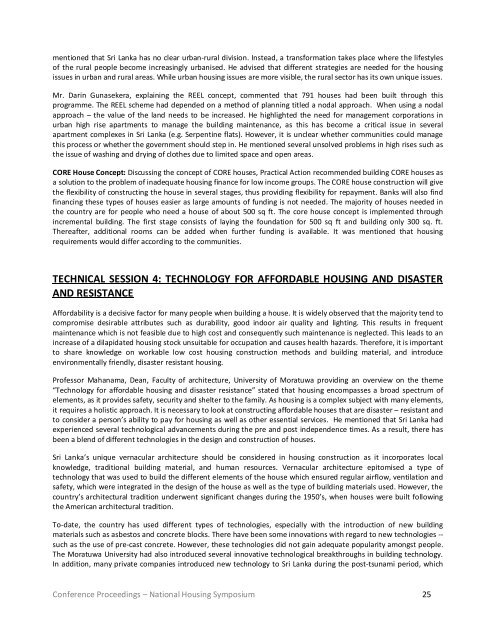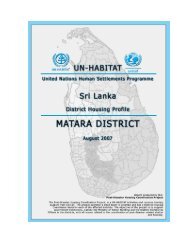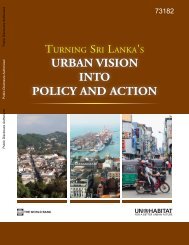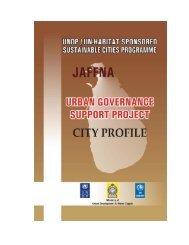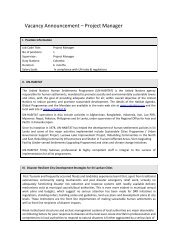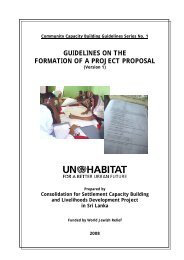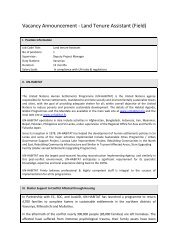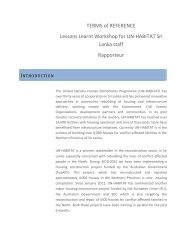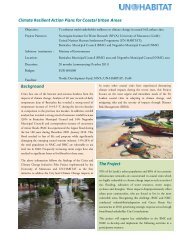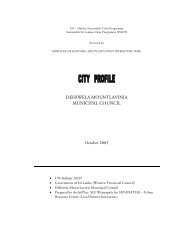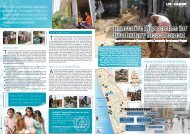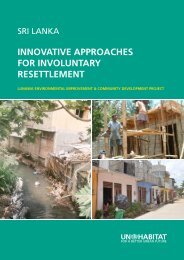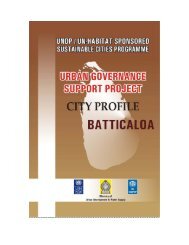Conference Proceedings : âJANASEVANAâ National ... - UN HABITAT
Conference Proceedings : âJANASEVANAâ National ... - UN HABITAT
Conference Proceedings : âJANASEVANAâ National ... - UN HABITAT
You also want an ePaper? Increase the reach of your titles
YUMPU automatically turns print PDFs into web optimized ePapers that Google loves.
mentioned that Sri Lanka has no clear urban‐rural division. Instead, a transformation takes place where the lifestyles<br />
of the rural people become increasingly urbanised. He advised that different strategies are needed for the housing<br />
issues in urban and rural areas. While urban housing issues are more visible, the rural sector has its own unique issues.<br />
Mr. Darin Gunasekera, explaining the REEL concept, commented that 791 houses had been built through this<br />
programme. The REEL scheme had depended on a method of planning titled a nodal approach. When using a nodal<br />
approach – the value of the land needs to be increased. He highlighted the need for management corporations in<br />
urban high rise apartments to manage the building maintenance, as this has become a critical issue in several<br />
apartment complexes in Sri Lanka (e.g. Serpentine flats). However, it is unclear whether communities could manage<br />
this process or whether the government should step in. He mentioned several unsolved problems in high rises such as<br />
the issue of washing and drying of clothes due to limited space and open areas.<br />
CORE House Concept: Discussing the concept of CORE houses, Practical Action recommended building CORE houses as<br />
a solution to the problem of inadequate housing finance for low income groups. The CORE house construction will give<br />
the flexibility of constructing the house in several stages, thus providing flexibility for repayment. Banks will also find<br />
financing these types of houses easier as large amounts of funding is not needed. The majority of houses needed in<br />
the country are for people who need a house of about 500 sq ft. The core house concept is implemented through<br />
incremental building. The first stage consists of laying the foundation for 500 sq ft and building only 300 sq. ft.<br />
Thereafter, additional rooms can be added when further funding is available. It was mentioned that housing<br />
requirements would differ according to the communities.<br />
TECHNICAL SESSION 4: TECHNOLOGY FOR AFFORDABLE HOUSING AND DISASTER<br />
AND RESISTANCE<br />
Affordability is a decisive factor for many people when building a house. It is widely observed that the majority tend to<br />
compromise desirable attributes such as durability, good indoor air quality and lighting. This results in frequent<br />
maintenance which is not feasible due to high cost and consequently such maintenance is neglected. This leads to an<br />
increase of a dilapidated housing stock unsuitable for occupation and causes health hazards. Therefore, it is important<br />
to share knowledge on workable low cost housing construction methods and building material, and introduce<br />
environmentally friendly, disaster resistant housing.<br />
Professor Mahanama, Dean, Faculty of architecture, University of Moratuwa providing an overview on the theme<br />
“Technology for affordable housing and disaster resistance” stated that housing encompasses a broad spectrum of<br />
elements, as it provides safety, security and shelter to the family. As housing is a complex subject with many elements,<br />
it requires a holistic approach. It is necessary to look at constructing affordable houses that are disaster – resistant and<br />
to consider a person’s ability to pay for housing as well as other essential services. He mentioned that Sri Lanka had<br />
experienced several technological advancements during the pre and post independence times. As a result, there has<br />
been a blend of different technologies in the design and construction of houses.<br />
Sri Lanka’s unique vernacular architecture should be considered in housing construction as it incorporates local<br />
knowledge, traditional building material, and human resources. Vernacular architecture epitomised a type of<br />
technology that was used to build the different elements of the house which ensured regular airflow, ventilation and<br />
safety, which were integrated in the design of the house as well as the type of building materials used. However, the<br />
country’s architectural tradition underwent significant changes during the 1950’s, when houses were built following<br />
the American architectural tradition.<br />
To‐date, the country has used different types of technologies, especially with the introduction of new building<br />
materials such as asbestos and concrete blocks. There have been some innovations with regard to new technologies ‐‐<br />
such as the use of pre‐cast concrete. However, these technologies did not gain adequate popularity amongst people.<br />
The Moratuwa University had also introduced several innovative technological breakthroughs in building technology.<br />
In addition, many private companies introduced new technology to Sri Lanka during the post‐tsunami period, which<br />
<strong>Conference</strong> <strong>Proceedings</strong> – <strong>National</strong> Housing Symposium 25


